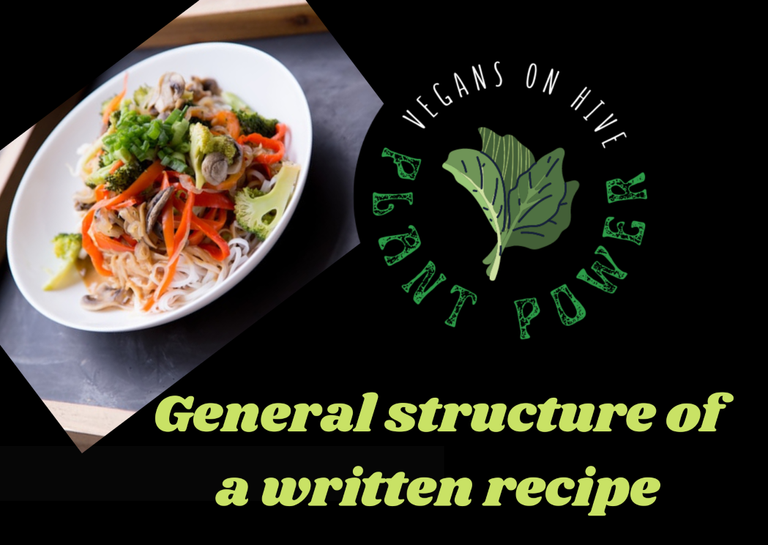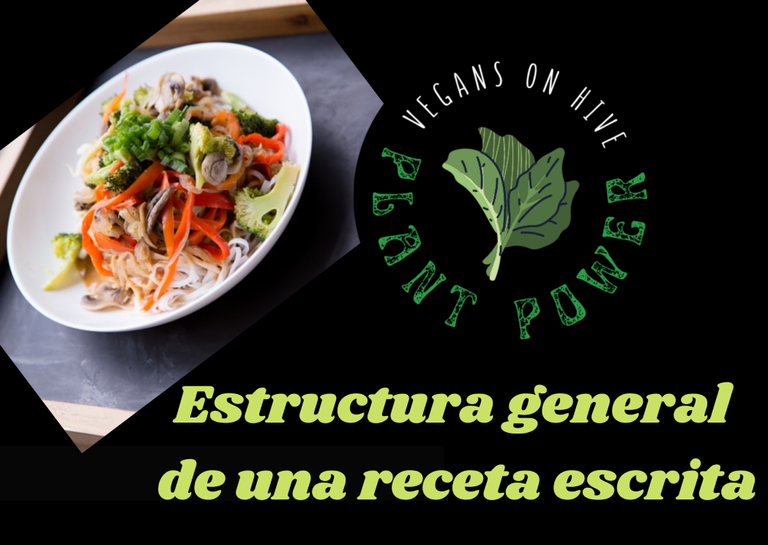
ENGLISH
Hello plant-based foodies, wherever you are in the world and/or galaxy!
Here @sirenahippie
We have seen that many users are presenting good recipes, but when it comes to posting, them they do not do so in a coherent and neat manner, so we infer that they require certain guidelines; hence, below we will offer a GENERAL STRUCTURE FOR WRITTEN RECIPES. Needless to say, the recipes presented in this community must be 100% vegan, and also that users must respect our COMMUNITY RULES.

GENERAL STRUCTURE FOR WRITTEN RECIPES
A recipe is a process, and how it must be developed and presented based on a basic general structure, with a logical and coherent order, which must be respected, (although it can be expanded and enriched); so we propose the following structure:
IMPORTANT NOTE: Here we present for explanatory purposes, subtitles of the parts that make up the proposed general structure, however THESE SUBTITLES SHOULD NOT BE INCLUDED IN THE RECIPES PUBLISHED IN THIS COMMUNITY.
TITLE:
- In this community the title must be written in English, although it can also be bilingual.
- The title should be short, reflecting the essence of the recipe. DO NOT write a long sentence in the title, as this tires and overwhelms the reader.
- Omit scientific names within the title.
- DO NOT USE a full stop in the title. TITLES ARE NOT ENDED WITH POINTS, as they are titles, not paragraphs.
INTRODUCTION:
- Every recipe must have an introduction, with one or several previous paragraphs, where a presentation of the recipe is made.
- In this introduction you can talk in a general way about the recipe, whether or not it is traditional, whether or not it is known to you, how you learned to make it, what feelings you experience when you make it, if it is a recipe linked to a holiday, if it is simple or complicated, etc. The important thing is that they give a preview of the recipe.
- Accompany the introduction with a photo of the dish already served, plated, as this will serve as a reference for the reader to know what the ready-made recipe looks like. This photo must be excellent, that hooks the reader, that the food enters their eyes and makes them want to read the recipe.
LIST OF INGREDIENTS, TIMES REQUIRED, SERVINGS OBTAINED:
- A recipe without a well-specified list of ingredients, which includes ALL the ingredients, including the water to be used, is an incomplete recipe. So it is MANDATORY to include a list of ingredients expressed in units of measurement: Kilos, grams, liters, milliliters, tablespoons, pounds, etc. Avoid as much as possible expressions such as “a large potato”, “a medium pepper”, “a small pumpkin”, “a splash of vinegar”, “a handful of cilantro”, as they are subjective measurements.
- The importance of the list of ingredients is FUNDAMENTAL, as it will allow readers to make the recipes later, so it must be very exact.
- It is advisable to present a photo of the ingredients.
- Regarding the times required, this information is also essential, because it will allow readers to know how much time they will need to prepare the recipe.
- The servings obtained are also basic data, as this will help readers estimate how much food they will get from the recipe.
RECIPE DEVELOPMENT:
- As already indicated, a recipe is a process, and therefore has a coherent and logical order, divided into steps. All steps must be explained and accompanied by photos, so that readers can clearly understand how to make the recipe.
- Try to be very punctual when explaining the recipe. Remember that you do know how to make the dish you present, whoever reads it may not.
RECIPE CONCLUSION:
- At this point it is appropriate to describe the result obtained, what you thought of the process (easy, difficult, pleasant, unpleasant...), the taste of the food, what you would accompany it with, on what occasions you would eat it, etc.
- Include one or more photos of the already served, plated dish. These photos must be different from the one that accompanies the introduction and must be very good too.

As you can see, the GENERAL STRUCTURE proposed for written recipes is simple, easy to implement and will undoubtedly give a better presentation to your posts. We hope you take this suggestion into account


ESPAÑOL

¡Hola amantes de los alimentos basados en plantas, dondequiera que estén en el mundo y/o la galaxia!
Aquí @sirenahippie
Hemos visto que muchos usuarios están presentando buenas recetas, pero a la hora de plasmarlas no lo hacen de manera coherente y prolija, por lo que inferimos que requieren ciertas orientaciones; de allí que a continuación ofreceremos una ESTRUCTURA GENERAL PARA RECETAS ESCRITAS. Demás está decir que las recetas que se presenten en esta comunidad, deben ser 100% veganas, y también, que los usuarios deben respetar nuestras REGLAS COMUNITARIAS.

ESTRUCTURA GENERAL PARA RECETAS ESCRITAS
Una receta es un proceso, y como debe desarrollarse y presentarse en base a una estructura general básica, con un orden lógico y coherente, el cual debe respetarse, (aunque sí puede ampliarse, enriquecerse); así que proponemos la siguiente estructura:
NOTA IMPORTANTE: Aquí presentamos con fines explicativos, subtítulos de las partes que conforman a la estructura general propuesta, sin embargo ESTOS SUBTÍTULOS NO DEBEN SER INCLUIDOS EN LAS RECETAS PUBLICADAS EN ESTA COMUNIDAD.
TÍTULO:
- En esta comunidad el título debe ser escrito en Inglés, aunque también puede ser bilingüe.
- El título debe ser corto, que refleje la esencia de la receta. NO extenderse con una larga oración en el título, pues esto cansa y abruma al lector.
- Omitir nombres científicos dentro del título.
- NO USAR punto y aparte en el título. LOS TÍTULOS NO SE FINALIZAN CON PUNTOS, pues son títulos, no párrafos.
INTRODUCCIÓN:
- Toda receta debe llevar una introducción, de uno o varios párrafos previos, en donde se haga una presentación de la receta.
- En esta introducción pueden hablar de forma general acerca de la receta, si es o no tradicional, si es o no conocida para ustedes, cómo aprendieron a hacerla, qué sentimientos experimentan cuando la hacen, si es una receta vinculada con alguna festividad, si es sencilla o complicada, etc. Lo importante es que den una visión previa de la receta.
- Acompañar la introducción con una foto del plato ya servido, emplatado, pues esto servirá de referencia al lector para saber cómo luce la receta ya hecha. Esta foto debe ser excelente, que enganche al lector, que la comida le entre por los ojos y desee leer la receta.
LISTA DE INGREDIENTES, TIEMPOS REQUERIDOS, PORCIONES OBTENIDAS:
- Una receta sin una lista de ingredientes bien especificada, que incluya TODOS los ingredientes, incluso el agua a ser empleada, es una receta incompleta. Así que es OBLIGATORIO incluir una lista de ingredientes expresada en unidades de medidas: Kilos, gramos, litros, mililitros, cucharadas, libras, etc. Evitar al máximo expresiones como “una papa grande”, “un pimiento mediano”, “una calabaza pequeña”, “un chorrito de vinagre”, “un puñado de cilantro”, pues son medidas subjetivas.
- La importancia de la lista de ingredientes es FUNDAMENTAL, pues permitirá a los lectores hacer las recetas posteriormente, así que se debe ser muy exacta.
- Es recomendable presentar una foto de los ingredientes.
- En cuanto a los tiempos requeridos, esta información también es esencial, porque permitirá a los lectores saber cuánto tiempo requerirán para elaborar la receta.
- Las porciones obtenidas también es un dato básico, pues esto ayudará a los lectores a estimar cuánta comida obtendrán de la receta.
DESARROLLO DE LA RECETA:
- Como ya se indicó, una receta es un proceso, y por tanto tiene un orden coherente y lógico, dividido en pasos. Todos los pasos deben ser explicados y acompañados de fotos, para que los lectores puedan comprender claramente cómo hacer la receta.
- Tratar de ser muy puntuales al explicar la receta. Recuerden que ustedes sí saben hacer el platillo que presentan, quien lo lee quizás no.
CONCLUSIÓN DE LA RECETA:
- En este punto es apropiado describir el resultado obtenido, qué les pareció a ustedes el proceso (fácil, difícil, agradable, desagradable…), el sabor de la comida, con qué lo acompañarían, en qué ocasiones lo comerían, etc.
- Incluir una o más fotos del plato ya servido, emplatado. Estas fotos deben ser distintas a la que acompaña a la introducción y deben ser muy buenas también.

Como pueden ver, la ESTRUCTURA GENERAL propuesta para las recetas escritas, es simple, fácil de implementar y sin duda alguna le dará a sus posts una mejor presentación. Esperamos tomen en cuenta esta sugerencia

RELATED POSTS / POSTS RELACIONADOS


Delegations welcome!
Thanks so much for the well detailed explanations. I will be presenting a delicious recipe today.
!ALIVE
We hope this information is useful to you
Sure it is
Thanks for the general structure of recipe writing, it's great to gain new knowledge in recipe development! Hopefully in the future we as recipe writers can be better at writing!. Pelukan❤️
Your recipes are very good, you have always made good posts. Thank you for your nice comment.
Hugs for you too!
Before engaing in posting in any community, it is very important to know the rules.
Thanks for sharing this
These are not the rules. The rules are pinned to the right of our main screen. This is a suggestion of the general structure of written recipe posts. Thank you for your visit and comment.
Nice suggestions I often forget to tell the water I use and the time I will made in the next recipes, as the phot of the end dish I use to put them to the end and use as a first picture the one I made with canva is it ok too?
If you are going to use water to wash food, you can write something like "enough water to wash food", however, if you are going to make a cream, a soup, the water to be used must be writed, either in milliliters or liters.
Regarding the photo, it would be great if you used one on the cover (the one you design with Canva) and another at the end, with your dish ready.
That is a nice explanation of how to write a post/recipe thanks @plantpoweronhive. :)
Thanks for your kind comment @hindavi
Hugs!
!BBH
Thanks @furstlight
Thank you for this detailed guidelines to recipe structure and development @plantpoweronhive @sirenahippie . This is very vital and crucial and I know each and everyone of us needs it for a better presentation in our loving community @plantpoweronhive .
Greetings community 🥰💕.
Thanks for your nice comment @sunshine29
Greetings!
Thank you too @plantpoweronhive for all you do for us 🥰💕🌺
Thank you, very interesting data to improve and enrich our publications.
Greetings 😊
You're welcome @carisma77
Hugs!
Excelente sugerencias, voy a ponerla en práctica, gracias por guiarnos 👍